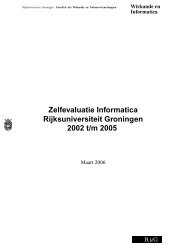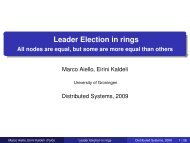Reverse Engineering – Recent Advances and Applications
Reverse Engineering – Recent Advances and Applications
Reverse Engineering – Recent Advances and Applications
Create successful ePaper yourself
Turn your PDF publications into a flip-book with our unique Google optimized e-Paper software.
22 <strong>Reverse</strong> <strong>Engineering</strong> <strong>–</strong> <strong>Recent</strong> <strong>Advances</strong> <strong>and</strong> <strong>Applications</strong><br />
20 Will-be-set-by-IN-TECH<br />
than source code (Kettu et al., 2008). This approach is most promising if source code<br />
is transformed to an underlying intermediate representation or virtual machine (e.g., Java<br />
bytecode or .NET CIL code) because in this case higher-level information is often preserved.<br />
In contrast, if source code is translated to machine-executable binaries, which is typically the<br />
case for C/C++, then most of the higher-level information is lost. For example, for C++ the<br />
binaries often do not allow to reconstruct all classes <strong>and</strong> their inheritance relationships (Fokin<br />
et al., 2010).<br />
Many complex embedded systems have features of a product line (because the software<br />
supports a portfolio of different devices). <strong>Reverse</strong> engineering different configurations <strong>and</strong><br />
variablity points would be highly desirable. A challenge is that often ad hoc techniques are<br />
used to realize product lines. For instance, Kettu et al. (2008) describe a C/C++ system that<br />
uses a number different techniques such as conditional compilation, different source files <strong>and</strong><br />
linkages for different configurations, <strong>and</strong> scripting. Generally, there is research addressing<br />
product lines (e.g., (Alonso et al., 1998; Obbink et al., 1998; Stoermer et al., 2003)), but there<br />
are no mature techniques or tools of broader applicability.<br />
5.3 Dynamic analyses<br />
Research into dynamic analyses have increasingly received more attention in the reverse<br />
engineering community. There are also increasingly hybrid approaches that combine both<br />
static <strong>and</strong> dynamic techniques. Dynamic approaches typically provide information about a<br />
single execution of the system, but can also accumulate information of multiple runs.<br />
Generally, since dynamic analyses naturally produce (time-stamped) event sequences, they<br />
are attractive for underst<strong>and</strong>ing of timing properties in complex embedded systems. The<br />
Tracealyzer is an example of a visualization tool for embedded systems focusing on high-level<br />
runtime behavior, such as scheduling, resource usage <strong>and</strong> operating system calls (Kraft<br />
et al., 2010). It displays task traces using a novel visualization technique that focuses on<br />
the task preemption nesting <strong>and</strong> only shows active tasks at a given point in time. The<br />
Tracealyzer is used systematically at ABB Robotics <strong>and</strong> its approach to visualization has<br />
proven useful for troubleshooting <strong>and</strong> performance analysis. The E-CARES project found<br />
that “structural [i.e., static] analysis . . . is not sufficient to underst<strong>and</strong> telecommunication<br />
systems” because they are highly dynamic, flexible <strong>and</strong> reactive (Marburger & Westfechtel,<br />
2003). E-CARES uses tracing that is configurable <strong>and</strong> records events that relate to signals<br />
<strong>and</strong> assignments to selected state variables. Based on this information UML collaboration<br />
<strong>and</strong> sequence diagrams are constructed that can be shown <strong>and</strong> animated in a visualizer.<br />
The Darwin project relies on dynamic analyses <strong>and</strong> visualization for reverse engineering of<br />
MRI scanners. Customizable mapping rules are used to extract events from logging <strong>and</strong><br />
run-time measurements to construct so-called execution viewpoints. For example, there are<br />
visualizations that show with different granularity the system’s resource usage <strong>and</strong> start-up<br />
behavior in terms of execution times of various tasks or components in the system (Arias et al.,<br />
2009; 2011).<br />
Cornelissen et al. (2009) provide a detailed review of existing research in dynamic analyses for<br />
program comprehension. They found that most research focuses on object-oriented software<br />
<strong>and</strong> that there is little research that targets distributed <strong>and</strong> multi-threaded applications.<br />
Refocusing research more towards these neglected areas would greatly benefit complex




